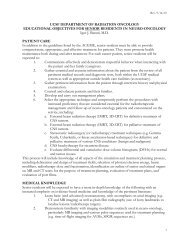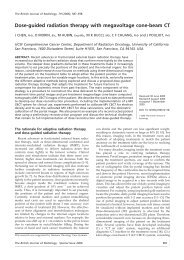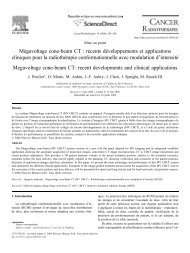Soft Tissue Visualization Using a Highly Efficient Megavoltage Cone ...
Soft Tissue Visualization Using a Highly Efficient Megavoltage Cone ...
Soft Tissue Visualization Using a Highly Efficient Megavoltage Cone ...
Create successful ePaper yourself
Turn your PDF publications into a flip-book with our unique Google optimized e-Paper software.
3.2.2 Patient Images<br />
Figure 6: Receptor 1Head phantom images with gold seeds<br />
All patient images were acquired at SID of 145cm. Figure 7 shows a pelvis image acquired with<br />
receptor 1. Total dose was 16cGy and preprocessing adaptive filter was applied to the projection<br />
images. The contribution of beam profile and scatter effects that cause shading artefacts are minimized<br />
by obtaining empirical data (from different anatomies, SID, and patient sizes) and linking to the<br />
correction images. Figure 8 compares the axial view of 8cGy MV CBCT with the planning CT image<br />
and shows that the most of the soft tissue structures such as prostate are detectable with MV CBCT.<br />
Figures 9 and 10 depict axial, coronal and sagittal head/neck images that were acquired with receptors<br />
1 and 2 by delivering 16 and 6cGy, respectively. Optic nerves are detectable in both figures. Figure 11<br />
compares the lateral views of MV CBCT images acquired for three different patients over the past year<br />
and shows the improvement in image quality.<br />
One distinct advantage of MV CBCT imaging is that image quality is maintained even when high-Z<br />
materials such as tooth fillings, dental implants, fiducial markers or hip replacements are present. For<br />
kV imaging, these objects create strong artifacts. This is illustrated in the figure 12.<br />
Figure 7: Pelvis MV CBCT with receptor 1 using 16cGy
















